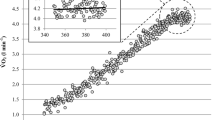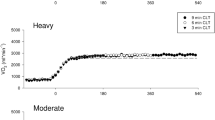Abstract
Research into the rate of whole-body oxygen consumption (VO2) kinetics during exercise increments to low- to moderate-intensity steady-state exercise was originally based on the theory of linear first-order VO2 kinetics, implying that the VO2 response to steady-state exercise increments is a mono-exponential response of the same time constant (tau, τ) across all steady-state intensities. Despite the acceptance of this theory for more than 30 years, early research from the 1980s documented an increasing τ with increasing steady-state exercise intensity, and recent research has confirmed such results. Today, such evidence has led to retraction of the theory of linear first-order VO2 kinetics. This history, revealing the premature acceptance of a theory, and subsequent scientific investigation using improved research design, instrumentation and data processing, has important implications for the fragility of scientific theories and the need for continual testing of theories in the search for facts and not prematurely accepted constructs. This review provides historical evidence for a critical reappraisal of the theory of linear first-order VO2 kinetics and presents data to show the need for changes in the data-processing ‘standards’ of the discipline to improve measurement of instantaneous VO2 kinetics and the time to steady state. For example, to date, no study of VO2 kinetics has quantified and statistically analysed the time to steady state. Furthermore, the instability of τ across different exercise increments, and for the same increment from different baseline VO2 demand, prevents τ from being a valid measure of VO2 kinetics for different exercise conditions. The concept of quantifying kinetics from a total non-linear response, when no other field of kinetics pursues this methodology, also raises concern for the methods and models used to interpret steady-state VO2 kinetics.







Similar content being viewed by others
References
Krogh A, Lindhard J. The regulation of respiration and circulation during the initial stage of muscular work. J Physiol. 1913;47:112–36.
Henry FH, DeMoor JC. Lactic and alactic oxygen consumption in moderate exercise of graded intensity. J Appl Physiol. 1956;8:608–14.
Magaria R, Manglli F, Cuttica F, et al. The kinetics of the oxygen consumption at the onset of muscular exercise in man. Ergonomics. 1965;8:49–54.
Cerretelli P, Sikand R, Farhi LE. Readjustments in cardiac output during the onset of exercise and recovery. J Appl Physiol. 1966;21:1345–50.
Cerretelli P, Shindell D, Pendergast DP, et al. Oxygen uptake transients at the onset and offset of arm and leg work. Respir Physiol. 1977;30:81–97.
Linnarsson D. Dynamics of pulmonary gas exchange and heart rate changes at start and end of exercise. Acta Physiol Scand. 1974;(Supplementum 415):1–68.
Whipp BJ. Rate constant for the kinetics of oxygen uptake during light exercise. J Appl Physiol. 1971;3:261–3.
Di Prampero PE, Davies CTM, Cerretelli P, et al. An analysis of O2 debt contracted in submaximal exercise. J Appl Physiol. 1970;29:547–51.
Di Prampero PE, Mahler PB, Giezendanner D, et al. Effects of priming exercise on VO2 kinetics and O2 deficit at the onset of stepping and cycling. J Appl Physiol. 1989;66:2023–31.
Ozyener F, Rossiter HB, Ward SA, et al. Influences of exercise intensity on the on- and off-transient kinetics of pulmonary oxygen uptake in humans. J Physiol. 2001;533:891–902.
Zoladz JA, Korzeniewski B, Grassi B. Training-induced acceleration of oxygen uptake kinetics in skeletal muscle: the underlying mechanisms. J Physiol Pharmacol. 2006;57(Suppl 10):67–82.
Zhang Y, Johnson MC, Chow N, et al. The role of fitness on VO2 and VCO2 kinetics in response to proportional step increases in work rate. Eur J Appl Physiol. 1991;63:94–100.
Brittain CJ, Rossiter HB, Kowalchuk JM, et al. Effect of prior metabolic rate on the kinetics of oxygen uptake during moderate-intensity exercise. Eur J Appl Physiol. 2001;86:125–34.
Hernandez A, McDonald JR, Lai N, et al. A prior bout of contractions speeds VO2 and blood flow on-kinetics and reduces the VO2 slow-component amplitude in canine skeletal muscle contracting in-situ. J Appl Physiol. 2010;108:1169–76.
Koga S, Shijiri T, Kondo N. Measuring VO2 kinetics. In: Jones AM, Poole DC, editors. Oxygen uptake kinetics in sport, exercise and medicine: a practical handbook. New York: Routledge; 2005. p. 39–61.
Murias JM, Kowalchuk JM, Paterson DH. Speeding of VO2 kinetics during moderate-intensity exercise subsequent to heavy-intensity exercise is associated with improved local O2 distribution. J Appl Physiol. 2009;108:913–22.
Bell C, Paterson DH, Kowalchuk JM, et al. Oxygen uptake kinetics of older humans are slowed with age but are unaffected by hyperoxia. Exp Physiol. 1999;84:747–59.
Grassi B, Rossiter HB, Hogan MC, et al. Faster O2 uptake kinetics in canine skeletal muscle in situ after acute creatine kinase inhibition. J Physiol. 2011;589:221–33.
Fujihara Y, Hilderbrandt JR, Hilderbrandt J. Cardiorespiratory transients in exercising man. I. Tests of superposition. J Appl Physiol. 1973;35:58–67.
Jones AM, Poole DC. Introduction to oxygen uptake kinetics and historical development of the discipline. In: Jones AM, Poole DC, editors. Oxygen uptake kinetics in sport, exercise and medicine: a practical handbook. New York: Routledge; 2005. p. 3–36.
Whipp BJ, Wasserman KW. Oxygen uptake kinetics for various intensities of constant-load work. J Appl Physiol. 1972;3:351–6.
Paterson DH, Whipp BJ. Asymmetries of oxygen uptake transients at the on- and offset of heavy exercise in humans. J Physiol. 1991;443:575–86.
Barstow TJ, Casaburi R, Wasserman K. O2 uptake kinetics and the O2 deficit as related to exercise intensity and blood lactate. J Appl Physiol. 1993;75:755–62.
Barstow TJ, Mole PA. Linear and nonlinear characteristics of oxygen uptake kinetics during heavy exercise. J Appl Physiol. 1991;71:2099–106.
Leclair E, Berthoin S, Borel B, et al. Faster pulmonary oxygen uptake kinetics in children vs adults due to enhancements in oxygen delivery and extraction. Scand J Med Sci Sports. 2013;23:705–12. doi:10.1111/j.1600-0838.2012.01446.x.
Wackerhage H, Hoffman U, Essfeld D, et al. Recovery of free ADP, Pi, and free energy of ATP hydrolysis in human skeletal muscle. J Appl Physiol. 1998;85:2140–5.
Do-yeon K, Robergs RA. Validation of a new mixing chamber system for breath-by-breath indirect calorimetry. Appl Physiol Nutr Metab. 2012;37(1):156–66.
Whipp BJ. Dynamics of pulmonary oxygen uptake. Circulation. 1987;76:18–28.
Whipp BJ, Ward SA. Physiological determinants of pulmonary gas exchange kinetics during exercise. Med Sci Sports Exerc. 1990;22:62–71.
Xu F, Rhodes EC. Oxygen uptake kinetics during exercise. Sports Med. 1999;27:313–27.
Bowen TS, Murgatroyd SR, Cannon DT, et al. A raised metabolic rate slows pulmonary O2 uptake kinetics on transition to moderate-intensity exercise in humans independently of work rate. Exp Physiol. 2011;96(10):1049–61.
Casaburi R, Barstow TJ, Robinson T, et al. Influence of work rate on ventilatory and gas exchange kinetics. J Appl Physiol. 1989;67:547–55.
Hughson RH, Morrissey M. Delayed kinetics of respiratory gas exchange in the transition from prior exercise. J Appl Physiol. 1982;52(4):921–9.
Hughson RH, Morrisey MA. Delayed kinetics of VO2 in the transition from prior exercise. Evidence for O2 transport limitation of VO2 kinetics: a review. Int J Sports Med. 1983;4:31–9.
Hughson RH. Regulation of VO2 on-kinetics by O2 delivery. In: Jones AM, Poole DC, editors. Oxygen uptake kinetics in sport, exercise and medicine: a practical handbook. New York: Routledge; 2005. p. 185–211.
Koppo K, Bouckaert J, Jones AM. Effects of training status and exercise intensity on phase II VO2 kinetics. Med Sci Sports Exerc. 2004;36:225–32.
MacPhee SL, Shoemaker JK, Paterson DH, et al. Kinetics of O2 uptake, leg blood flow, and muscle deoxygenation are slowed in the upper compared with lower region of the moderate-intensity exercise domain. J Appl Physiol. 2004;99(5):1822–34.
Robergs RA, Dwyer D, Astorino T. Recommendations for improved data processing from expired gas analysis indirect calorimetry. Sports Med. 2010;40:95–111.
Carter H, Pringle JSM, Jones AM, et al. Oxygen uptake kinetics during treadmill running across exercise intensity domains. Eur J Appl Physiol. 2002;86:347–54.
Haseler LJ, Hogn MC, Richardson RS. Skeletal muscle phosphocreatine recovery in exercise-trained humans is dependent on O2 availability. J Appl Physiol. 1999;86:2013–8.
Poole D, Jones AM. Towards an understanding of the mechanistic bases of VO2 kinetics. In: Jones AM, Poole DC, editors. Oxygen uptake kinetics in sport, exercise and medicine: a practical handbook. New York: Routledge; 2005.
Katch V. The burden of disproof. Med Sci Sports Exerc. 1986;18:593–5.
Hickson RC, Bomze HA, Holloszy JO. Faster adjustment of O2 uptake to the energy requirement of exercise in the trained state. J Appl Physiol. 1978;44:877–81.
Berg WE. Individual differences in respiratory gas exchange during recovery from moderate exercise. Am J Physiol. 1947;149:597–610.
Popper K. The logic of scientific discovery. London: Routledge; 2002.
Korzeniewski B, Zoladz JA. Factors determining the oxygen consumption rate (VO2) on-kinetics in skeletal muscles. Biochem J. 2004;379:703–10.
Jones AM, Wilkerson DP, DiMenna F, et al. Muscle metabolic responses to exercise above and below the “critical power” assessed using 31P-MRS. Am J Physiol Regul Integr Comp Physiol. 2007;294:R585–93.
Rossiter HB, Ward SA, Doyle VL, et al. Inferences from pulmonary O2 uptake with respect to intramuscular [phosphocreatine] kinetics during moderate exercise in humans. J Physiol. 1999;518:921–32.
Rossiter HB, Howe FA, Ward SA. Intramuscular phosphate and pulmonary VO2 kinetic during exercise. In: Jones AM, Poole DC, editors. Oxygen uptake kinetics in sport, exercise and medicine: a practical handbook. New York: Routledge; 2005.
Pringle JSM, Doust JH, Carter H, et al. Oxygen uptake kinetics during moderate, heavy and severe intensity ‘submaximal’ exercise in humans: the influence of muscle fibre type and capillarization. Eur J Appl Physiol. 2003;89:289–300.
Andersen JL, Aagaard P. Influence of Influence of maximal muscle strength and intrinsic muscle contractile properties on contractile rate of force development. Eur J Appl Physiol. 2006;96:46–52.
Hagberg JM, Hickson RD, Ehsani AA, et al. Faster adjustment to and recovery from submaximal exercise in the trained state. J Appl Physiol. 1980;48:218–24.
Wilkerson DP, Koppo K, Barstow TJ, et al. Effect of work rate on the functional “gain” of phase II pulmonary O2 uptake response to exercise. Respir Physiol Neurobiol. 2004;142:211–23.
Acknowledgments
No sources of funding were used in the preparation of this review. The author has no potential conflicts of interest that are directly relevant to the content of the review.
Author information
Authors and Affiliations
Corresponding author
Rights and permissions
About this article
Cite this article
Robergs, R.A. A Critical Review of the History of Low- to Moderate-Intensity Steady-State VO2 Kinetics. Sports Med 44, 641–653 (2014). https://doi.org/10.1007/s40279-014-0161-2
Published:
Issue Date:
DOI: https://doi.org/10.1007/s40279-014-0161-2




